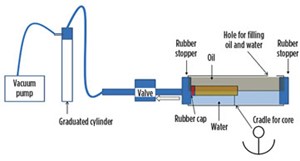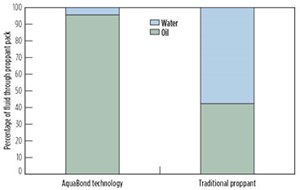Formation water reduction technology proves successful in the field
Produced water, or formation water, is naturally occurring water that is brought to the surface during oil and gas production. It is by far the largest by-product for the industry. While there is significant variation in the amount of formation water generated from established oil-and-gas-producing regions in the country, it is estimated that for every barrel of oil recovered, 4 to 10 bbl of formation water will be produced.
THE PROBLEM
Formation water often contains salts, bacteria, organic chemicals and other contaminants.1 Although some companies will treat the water for re-use in hydraulic fracturing or agriculture, this is not always an economical option. Most of the formation water is disposed of by injecting it into subterranean wastewater disposal wells.
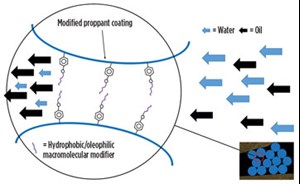
The U.S. upstream industry will spend an estimated $34.7 billion on water management in 2018. A complex logistical network accounts for storing, transferring, trucking, treating and disposing of formation water, and totals 89% of water management costs.2 Over the life of an individual well, formation water costs can total $6 million, representing up to half of a well’s operating expense.3 These costs are predicted to increase.
Record oil and gas production in the Permian basin also has generated record formation water production. If Permian basin oil output approaches 6 MMbpd by 2025, water-related expenditures in this region, alone, could reach $17 billion.4
Since many states in the American Northeast have tight restrictions on wastewater disposal, formation water is often trucked to neighboring states to be reinjected into disposal wells. The added water hauling costs severely impact well economics.
Due to the correlation between water reinjection and seismic activity, more restrictions have been added to disposal wells in Oklahoma. These restrictions limit the rate at which water can be reinjected, consequently increasing the cost associated with water management. Additionally, multi-well pad development can result in higher concentrations of water in a single area, which puts greater strain on nearby disposal wells. The disposal formations can pressure up too fast, limiting the injection rate and causing casing issues for wells that are close in proximity.4 An overloaded water transportation network and other limitations on wastewater disposal wells have added to this challenge.
Formation water handling and disposal continue to be important topics in the oil and gas industry, but little is being done to limit water production by addressing the issue at the source. An ideal solution to the challenges presented by the management of produced water would include reducing the amount of formation water generated without hindering hydrocarbon production. Current technologies, such as gels or swelling chemicals, can limit formation water production, but they restrict the flow of hydrocarbons.
THE SOLUTION
Researchers at Hexion were determined to develop a solution that would reduce formation water production, while maintaining oil and gas output. Technologies, such as OilPlus proppants, have demonstrated the ability to improve production in liquid-rich reservoirs by altering the surface chemistry of the proppant.5 The lessons learned from tailoring surface chemistry were leveraged to develop the patented AquaBond formation water reduction technology.
This technology has proven to reduce produced water by as much as 50%, while improving oil and gas production compared to offset wells. Since the technology is bonded to proppant, the water-reducing property stays effective for the life of the well. Utilization of the technology can increase well profitability by reducing costs associated with wastewater management, ultimately leading to a lower cost per barrel of oil equivalent (boe).
HOW IT WORKS
The AquaBond formation water reduction technology alters the relative permeability of the proppant pack to admit hydrocarbons and reduce the admission of water. The pack acts as a semi-permeable membrane to selectively allow hydrocarbons to penetrate while excluding formation water.
Modifications to the functional groups of the proppant coating result in a tailored critical surface tension that is hydrophobic and oleophilic at the same time, Fig. 1. This creates a driving force that tends to admit oil into the proppant pack, while reducing the flow of water through the proppant pack.6
LABORATORY TESTING
To demonstrate that this technology will preferentially flow hydrocarbons over water, a test apparatus was developed by Hexion to prove the concept. A bonded proppant core is attached to a tightly fitted rubber cap and placed in a reservoir cell. The rubber cap is affixed to a tube that extends from the reservoir and empties into a graduated cylinder. The reservoir cell is filled with oil and water, both of which are in contact with the proppant pack. A vacuum pump is used to pull fluid from the reservoir cell through the proppant pack. The fluid is collected in the graduated cylinder, and measurements are made to determine the water/oil ratio that the proppant pack admits. It is important to note that fluid must travel through the proppant pack, so that it can be collected in the graduated cylinder. Figure 2 shows a schematic drawing of the testing device.
The AquaBond technology proppant core was tested against a control of traditional resin-coated proppant. The starting water/oil ratio in the reservoir cell was 2:1, with both fluids in contact with the proppant core. Initial tests showed that the AquaBond technology proppant core admitted less than 5% water without hindering the oil flow. The control proppant core admitted nearly 60% water and less overall oil. Figure 3 shows the results of the testing. Laboratory oil (Isopar) and Houston tap water were used for this test, but the test was repeated multiple times, using various crude oil and formation water samples from different regions throughout North America. These corresponding tests yielded similar results.
AVOIDING A “WATER BLOCK”
Since the proppant pack is a porous medium, water can flow through the pack, if it is the only fluid in contact with the pack. This prevents a water block scenario from occurring in the proppant pack or at the formation surface/proppant pack interface. This was proven by modifying the previously described test. The starting water/oil ratio was adjusted to 5:1, so only water was in contact with the proppant core at the start of the test. Figure 4 is a picture of the AquaBond technology proppant core at the start of the modified test. When the test began, water flowed through the core until the oil made contact with the proppant pack. Once oil contacted the core, it preferentially flowed through, leaving the water behind in the reservoir cell. The control test with traditional resin-coated proppant continued to flow water, even after oil contacted the proppant core, leaving a majority of the oil in the reservoir cell.
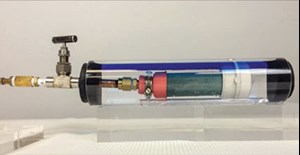
CASE STUDY
To prove that this technology is effective in the field, a trial was conducted in the Granite Wash formation of Roberts and Hemphill counties in the Texas Panhandle. A single operator utilized AquaBond technology on two horizontal wells, which were compared to 11 nearby offset horizontal wells. The wells utilizing this technology consisted of a 23% tail-in of 40/70 formation water-reducing proppant and a balance of uncoated frac sand. Three of the offset wells used a 23% tail-in of 40/70 traditional resin-coated proppant, and eight wells used 100% uncoated frac sand.
Completion details were similar for all wells in the data set: true vertical depth (TVD) was approximately 11,000 ft, with a lateral length of 4,000 ft, and bottomhole static temperature was 180°F. All wells used approximately 2.3 million lb of total proppant.
Figure 5 shows the results of the trial after nine months of production. Over the entire period, the traditional resin-coated proppant offsets and the uncoated frac sand wells performed about the same. The AquaBond technology wells had a 30% lower water cut, compared to the offsets. Average cumulative water production was reduced 43%, and no impact to total fluid production was observed.
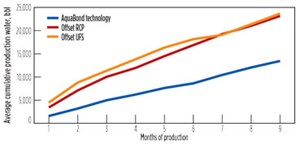
HOW TO USE THE TECHNOLOGY
The formation water-reduction technology requires no special equipment for use in hydraulic fracturing. The formation water reduction plan is outlined below:
- Pump downhole, using the same method as traditional proppants.
- Frac water returns to the surface, per typical flowback procedure.
- Hydrocarbons and formation water contact the chemically altered proppant pack.
- The AquaBond technology preferentially flows hydrocarbons over water.
- More oil and gas (and less water) are produced to the surface.
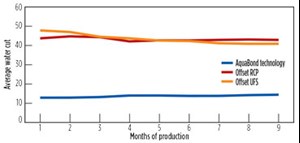
Post-job analysis can be used to optimize future completion designs, based on production data. Lead-ins, tail-ins or total proppant designs can be utilized, depending on formation characteristics, desired water reduction and/or severity of water issue. The technology also can be used as a remedial treatment for refracturing existing high-water-cut wells and has been used successfully in this application. Due to its flexibility and ease of use, the technology should be considered as a responsible part of any frac design incorporating an effective water management strategy.
CONCLUSION
Laboratory tests demonstrate that AquaBond technology will preferentially flow oil over water. These tests have been repeated multiple times, using different crude oil and produced water samples from various regions throughout North America. Testing also has been modified by varying water/oil ratios. When performing laboratory tests with only water in contact with the core incorporating AquaBond technology (or consolidated proppant pack), it was demonstrated that a water block will not occur.
This technology has been utilized in the Permian basin, Bakken shale, Granite Wash formation, and the Haynesville shale. It is applied using the same method as traditional proppants and requires no special equipment. The case study in the Granite Wash demonstrates how this technology can reduce the production of formation water without impacting total fluid production. ![]()
REFERENCES
- Graves, W.G., W.K. Ott, and J.D. Woods, Mature Oil & Gas Wells Downhole Remediation Handbook, 2004, Gulf Publishing Company, Houston, pp. 53 – 130.
- Includes content supplied by IHS; Copyright IHS, 2018. All rights reserved.
- Calculations made assuming 800,000 boe over the life of the well, 3 MMbbl of water, and a total water management cost of $2.00/bbl.
- Information from Wood Mackenzie, USA.
- Terracina, J.M. and A.K. Harper, February 2018, “Improving Well Economics with Advanced Proppants,” E&P, pp. 66–68.
- Green, J., A. Dewendt, and J. Terracina, “First proppant designed to decrease water production,” SPE paper 191394-MS, Sept. 26, 2018.
- What's new in production (February 2024)
- U.S. operators reduce activity as crude prices plunge (February 2024)
- U.S. producing gas wells increase despite low prices (February 2024)
- U.S. oil and natural gas production hits record highs (February 2024)
- Dallas Fed: E&P activity essentially unchanged; optimism wanes as uncertainty jumps (January 2024)
- Enhancing preparedness: The critical role of well control system surveys (December 2023)
- Applying ultra-deep LWD resistivity technology successfully in a SAGD operation (May 2019)
- Adoption of wireless intelligent completions advances (May 2019)
- Majors double down as takeaway crunch eases (April 2019)
- What’s new in well logging and formation evaluation (April 2019)
- Qualification of a 20,000-psi subsea BOP: A collaborative approach (February 2019)
- ConocoPhillips’ Greg Leveille sees rapid trajectory of technical advancement continuing (February 2019)

